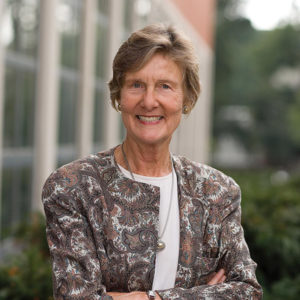calsfoundation@cals.org
Nannerl Overholser Keohane (1940–)
Nannerl Overholser Keohane has been a leader in American higher education, first as president of Wellesley College and then as president of Duke University. Both symbolically, as a pioneering female leader, and substantively in the way she shaped the direction of those two institutions, Keohane has had a major impact on the college and university landscape into the twenty-first century.
Nannerl Overholser was born on September 18, 1940, in Blytheville (Mississippi County). The daughter of Grace Overholser and James Overholser, who was a Presbyterian minister, she was the oldest of three children and was named after Wolfgang Amadeus Mozart’s sister. The family relocated several times during her childhood, both to Texas and to South Carolina, as well as a stint in Texarkana (Miller County), before settling in Hot Springs in 1952.
In 1957, Overholser graduated as valedictorian from Hot Springs High School. She attended Wellesley College on a scholarship, majoring in political science. She was named a Durant Scholar (the college’s highest award) and graduated Phi Beta Kappa. After studying at Oxford University in England on a Marshall Scholarship, she earned a PhD in political science from Yale University in 1967. She then embarked on a comparatively short career as a scholar in the area of political philosophy, with faculty appointments at Swarthmore College, the University of Pennsylvania, and Stanford University
She married Robert O. Keohane, himself a well-respected political scientist; they have four children.
Nannerl Keohane was teaching at Stanford when she was approached by her alma mater about serving as Wellesley’s president, even though she had none of the experience common for the job. However, due to her status as an alumna, she was a popular choice coming on the heels of the sometimes controversial tenure of Barbara Newell.
Assuming the presidency in 1981, twenty years after she had graduated from Wellesley, Keohane effectively led the effort to expand the college’s commitment to diversity and multiculturalism. In the midst of sometimes volatile economic times, the college maintained its commitment to need-blind admissions, and Keohane led a successful large-scale capital campaign. Meanwhile, the campus saw renovations and major additions, including a new sports center (which is named after her), the Davis Museum and Cultural Center, and a campus daycare center. The campus’s computer facilities were expanded, the library’s catalog was automated, and the college launched its first website during her tenure.
In 1992, she accepted an offer to assume the presidency of Duke University. Taking office in July 1993, Keohane was only the second woman to lead a major American research university, as well as the first to head one with a Division I athletic program. She pledged to raise money; solidify the university’s academic program; improve relations between the university and the Durham, North Carolina, community; and enhance the school’s international reputation. She oversaw one of the largest capital campaigns in the history of higher education, one that raised more than $2.35 billion, and she led efforts that resulted in twenty-five new buildings being constructed on campus. Under Keohane’s leadership, the Robertson Scholarship program (a joint program of Duke and the University of North Carolina at Chapel Hill) and the Duke-Durham Neighborhood partnership were launched. During her tenure, Duke’s admissions became among the most selective in the country.
Upon leaving Duke in 2004, Keohane assumed a faculty position at Princeton University’s Woodrow Wilson School of Public and International Affairs, where she continues to teach and write as of 2013.
In July 2005, she accepted an invitation to join the Harvard Corporation, the seven-member board that oversees the operation of Harvard University. At the time of her appointment, she was the only member without a Harvard degree, but as the only former university chief executive, she also brought a distinctive perspective and set of experiences, all of which proved valuable as the corporation addressed a number of controversies. In 2010, Keohane published Thinking about Leadership.
For additional information:
Basinger, Julianne. “How Nan Keohane Is Changing Duke.” Chronicle of Higher Education, November 3, 2000. Online at http://Chronicle.com/article/How-Nan-Keohane-Is-Changing/18363 (accessed October 19, 2021).
“Former Presidents.” Wellesley College. http://www.wellesley.edu/about%20/president/formerpresidents (accessed October 19, 2021).
Holland, Laurence H. M. “An Intriguing Opportunity.” Harvard Crimson, June 7, 2007. Online at http://www.thecrimson.com/article/2007/6/7/an-intriguing-opportunity-when-nannerl-o/ (accessed October 19, 2021).
Lewis, Hunter. “Passion Marks Outgoing Duke President’s Tenure.” Duke Today Mobile, June 21, 2004. (Originally in Durham Herald-Sun, June 13, 2004). https://today.duke.edu/2004/06/tenure_0604.html (accessed October 19, 2021).
Livezey, Emilie Tavel. “Wellesley’s New President.” Christian Science Monitor, November 5, 1981. http://www.csmonitor.com/1981/1105/110554.html (accessed October 19, 2021).
William H. Pruden III
Ravenscroft School
 Divergent Prosperity and the Arc of Reform, 1968–2022
Divergent Prosperity and the Arc of Reform, 1968–2022 Nan Keohane
Nan Keohane 




Comments
No comments on this entry yet.